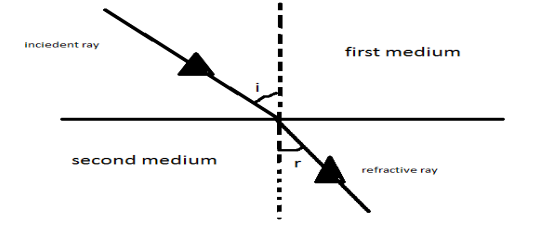
Calculate the critical angle for glass air interface if a ray of light incident on a glass surface is deviated through 15˚ when angle incident is 45˚.


Answer
566.1k+ views
Hint: (i) The incident ray, the refracted ray and the normal to the interface of two transparent media at the point of incidence, all lie in the same plane.
(ii) The ratio of sine of angle incidence to the sine of angle of refraction is a constant, for the light of given color and for the given pair of media. This constant is also called the refractive index of the second medium with respect to the first.

Formula used: When the ray of light enters the second medium through the fist medium.
\[\mu = \dfrac{{sin\left( i \right)}}{{sin\left( r \right)}}\]
Where, µ is the refractive index of glass.
‘$i$’ is the angle of incidence and ‘$r$’ is the angle of refraction.
Step by step solution:-
(a).
Given that,
Incident angle, deviated rays .
Let critical angle be \[{i_c}\].
Now,
\[sin{\text{ }}{i_c} = \mu \]
Where, \[\mu \] is the refractive index of glass.
Now, again \[i = r \& \] \[\dfrac{{sin{\text{ }}r}}{{sin{\text{ }}i}} = \mu \]
\[\Rightarrow \mu = \dfrac{{\sqrt 2 }}{2}\]
\[\Rightarrow \mu = \sqrt 2 \]
\[\Rightarrow \mu = 1.4\]
Now, the critical angle is
\[sin{i_c} = \dfrac{1}{\mu }\]
\[\Rightarrow sin{i_c} = \dfrac{1}{{1.4}}\]
\[\Rightarrow sin{i_c} = 0.71\]
\[\Rightarrow {i_c} = si{n^{ - 1}}\left( {0.71} \right)\]
Hence, the critical angle is ${45^ \circ }$.
Note :- Snell's law (also known as Snell–Descartes law and the law of refraction) is a formula used to describe the relationship between the angles of incidence and refraction, when referring to light or other waves passing through a boundary between two different isotropic media, such as water, glass, or air. In optics, the law is used in ray tracing to compute the angles of incidence or refraction, and in experimental optics to find the refractive index of a material.
(ii) The ratio of sine of angle incidence to the sine of angle of refraction is a constant, for the light of given color and for the given pair of media. This constant is also called the refractive index of the second medium with respect to the first.

Formula used: When the ray of light enters the second medium through the fist medium.
\[\mu = \dfrac{{sin\left( i \right)}}{{sin\left( r \right)}}\]
Where, µ is the refractive index of glass.
‘$i$’ is the angle of incidence and ‘$r$’ is the angle of refraction.
Step by step solution:-
(a).
Given that,
Incident angle, deviated rays .
Let critical angle be \[{i_c}\].
Now,
\[sin{\text{ }}{i_c} = \mu \]
Where, \[\mu \] is the refractive index of glass.
Now, again \[i = r \& \] \[\dfrac{{sin{\text{ }}r}}{{sin{\text{ }}i}} = \mu \]
\[\Rightarrow \mu = \dfrac{{\sqrt 2 }}{2}\]
\[\Rightarrow \mu = \sqrt 2 \]
\[\Rightarrow \mu = 1.4\]
Now, the critical angle is
\[sin{i_c} = \dfrac{1}{\mu }\]
\[\Rightarrow sin{i_c} = \dfrac{1}{{1.4}}\]
\[\Rightarrow sin{i_c} = 0.71\]
\[\Rightarrow {i_c} = si{n^{ - 1}}\left( {0.71} \right)\]
Hence, the critical angle is ${45^ \circ }$.
Note :- Snell's law (also known as Snell–Descartes law and the law of refraction) is a formula used to describe the relationship between the angles of incidence and refraction, when referring to light or other waves passing through a boundary between two different isotropic media, such as water, glass, or air. In optics, the law is used in ray tracing to compute the angles of incidence or refraction, and in experimental optics to find the refractive index of a material.
Recently Updated Pages
Why are manures considered better than fertilizers class 11 biology CBSE

Find the coordinates of the midpoint of the line segment class 11 maths CBSE

Distinguish between static friction limiting friction class 11 physics CBSE

The Chairman of the constituent Assembly was A Jawaharlal class 11 social science CBSE

The first National Commission on Labour NCL submitted class 11 social science CBSE

Number of all subshell of n + l 7 is A 4 B 5 C 6 D class 11 chemistry CBSE

Trending doubts
What is meant by exothermic and endothermic reactions class 11 chemistry CBSE

10 examples of friction in our daily life

One Metric ton is equal to kg A 10000 B 1000 C 100 class 11 physics CBSE

1 Quintal is equal to a 110 kg b 10 kg c 100kg d 1000 class 11 physics CBSE

Difference Between Prokaryotic Cells and Eukaryotic Cells

What are Quantum numbers Explain the quantum number class 11 chemistry CBSE




